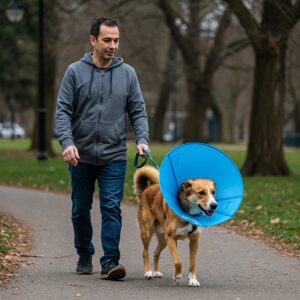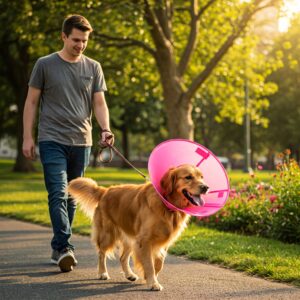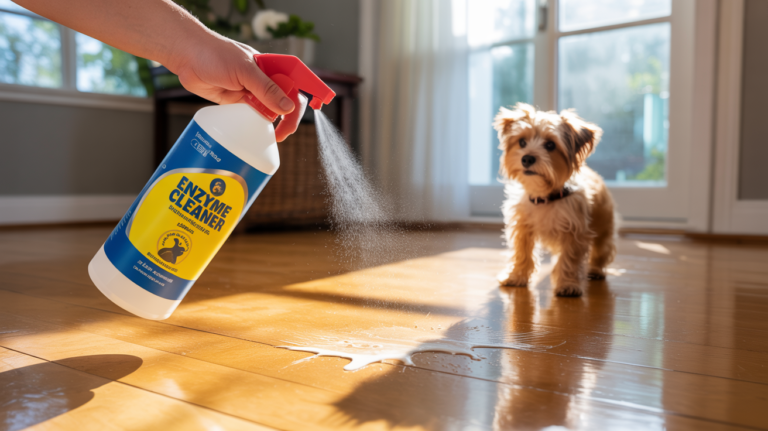How Soon Can I Walk My Dog After Neutering? Expert Recovery Guide
Neutering is one of those choices we make with love. It’s a little scary at first—your dog goes under the knife, there’s anesthesia, a healing wound. But it’s also something we do for health, for behavior, for peace of mind. Still, the moment you get back home, questions rush in. Can I walk him tomorrow? Will she be fine if we do a short stroll? Is rest enough? Or too much?
Let’s settle the worry and walk through what’s safe and what’s not. You’re not the only one asking.
How Soon Can I Walk My Dog After Neutering?
For most dogs, the golden rule is 48 hours of complete rest. No walks, no stairs, no zoomies, no playing fetch.
After the first two days, light leash walks only—5 to 10 minutes, slow pace. Just to pee. Just to poop. That’s it. Nothing more. No sniffing marathons. No uphill treks.
You are going to realize that after neutering, your dog isn’t just sleepy from surgery. There’s an incision. There are stitches or glue. And there’s the invisible healing you can’t see—tissues mending, soreness hiding beneath fur. All of which can be really discomforting.
Allowing the dog a complete 48 hours of rest is what is needed to restore normalcy to its system.

When Can I Walk My Dog After Surgery?
You can begin short walks around day 3 to 4, if your vet agrees. But here’s the trick: every dog heals at a different pace. Look at your dog. Watch how they move. Are they calm? Or are they trying to jump on furniture already?
Small breed dogs tend to recover faster, but don’t be fooled by their energy. Just because your dog acts fine doesn’t mean the incision site is safe.
If your vet gives the green light, gradually increase the walking time after 7 days—but no running or off-leash fun until after 14 days minimum, or whenever your vet confirms full healing.
How Long Should a Male Dog Rest After Being Neutered?
For male dogs, recovery might seem quicker. There’s no uterus, no deep internal surgery. But the scrotal area is sensitive. Swelling is common. Licking makes it worse. Jumping? Risky.
So even for males:
- First 48 hours: full rest, potty breaks only.
- Day 3 to 7: leash walks, 5 to 10 minutes max.
- Day 7 to 14: slow return to longer walks if no swelling, no redness, and your dog isn’t licking.
- After 14 days: back to regular activity if your vet says it’s okay.
If he’s still swollen, sore, or obsessed with the incision, wait longer. Healing matters more than a timeline.
How Far Can I Walk My Dog After Spaying?
Spaying is more intense than neutering. It’s abdominal surgery. They go into the belly, remove the uterus and ovaries. That takes time to heal.
So when it comes to walking, distance is not the goal—safety is.
For the first 7 days after spaying:
- Walks should be only 5 minutes, just enough for a bathroom break.
- Use a short leash so she doesn’t pull or chase after anything.
- No stairs, no jumping, no stretching up against fences or walls.
From day 7 to day 14, walks can be gently extended if the incision looks good. Still, stay on soft ground. Avoid gravel, hills, or anything that might strain her body.
Real recovery often takes up to 3 weeks, even if the incision closes sooner.
My Dog Keeps Jumping After Being Neutered
You’re not alone. A lot of dogs try to jump the moment they feel “okay.” But that’s the dangerous part. Just because they feel okay doesn’t mean they are okay.
Jumping pulls at the stitches. It stretches healing skin. It can cause internal tearing you won’t notice until there’s swelling or discharge.
When you notice that your dog keeps jumping after being neutered, do the following:
- Use a crate or small room for rest time.
- Block the couch with cushions or low barriers.
- Leash your dog indoors if you have to.
- Speak calmly when they’re excited, so they settle.
- Give them puzzle toys to distract their energy.
If your dog must jump to get on a bed, stop it. Lift them. Or better yet, keep them away from beds and couches until they’ve healed.
Exercise After Dog Spaying
We all want our dogs active and happy. But after spaying, too much too soon is a setback.
For the first 10 days, you need to ensure that the only exercise the dog is getting are potty breaks and leash walks. Keep them away from tug toys or rough play. Do not even attempt to play fetch. Focus on mental stimulation instead of physical exercising. Prioritizing lick mats, snuffle mats, and food puzzles.
By week two, if healing is smooth, you can try short play sessions indoors. Still controlled. Still soft surfaces. No running.
By week three, vet-approved walks can return to normal—but slowly. Think recovery, not rebound.
Let her body tell you the truth. If she’s sluggish, don’t push. If the incision swells, stop.
How Long After Neutering Dog Is Testosterone Gone?
This part surprises many people. You neuter a dog, and the behavior doesn’t change overnight. Why? Because testosterone lingers.
Even after the testicles are removed, testosterone remains in the bloodstream for up to 4 to 6 weeks.
So, you can expect mounting to still happen. Your dog is going to practice marking for a while so the aggression or reactivity will not disappear instantly.
Behavioral changes take time. Patience helps. And training still matters—even for neutered dogs.

FAQs
When Can a Dog Lick After Neutering?
Technically? Never. At least not until healing is 100% done. Licking opens wounds. It introduces bacteria. It delays recovery.
That’s why cones (e-collars) or inflatable collars are essential for at least 10 to 14 days. If your dog keeps licking, speak with your vet. You may need a stronger deterrent or even antibiotics if infection starts.
Can I Walk My Dog 2 Days After Spay?
Very short, very calm leash walks—yes, but only for bathroom breaks. No neighborhood walks. No “let’s go smell everything for 30 minutes.”
Keep it brief. Keep it safe.
How Long After Neutering Can I Bathe My Dog?
Wait at least 10 to 14 days, or until the incision is fully closed and dry. Water can soften the scab, cause bacteria to spread, or dissolve glue used on the incision.
If your dog smells, use vet-approved wipes or dry shampoo in the meantime.
What Happens If My Dog Jumps After Being Neutered?
Bad things. Torn stitches. Internal bleeding. Swelling. Infection. Pain.
Sometimes you don’t see the damage until hours later. That’s why prevention is key. Stop the jump before it happens.
If your dog already jumped and is now limping, swelling, or leaking fluid—call your vet immediately.
When to Take Cone Off Dog After Neuter?
The cone stays until the wound is dry, not swollen and not red. Also, you keep the cone until your dog is no longer licking or chewing. And most definitely until your vet says it is okay.
That usually means 10 to 14 days. Some dogs need longer. Don’t rush it.
Conclusion
Neutering is a small surgery with a big impact. But recovery? That’s where the care really happens. Give it time. Protect the incision. Walk slow. Rest more. And listen to your dog’s body, not just their energy.
A healed dog is a happy dog. And a little patience now saves a lot of pain later.
Let your dog heal in peace—and when it’s time, that walk will feel even better.
- Best Dog Car Seat For French Bulldog - October 1, 2025
- How to Prevent Scratches on Hardwood Floors from Dogs - October 1, 2025
- How To Protect Hardwood Floors From Scratches - October 1, 2025
